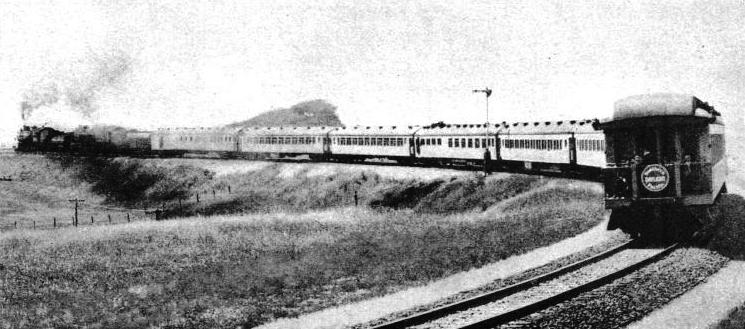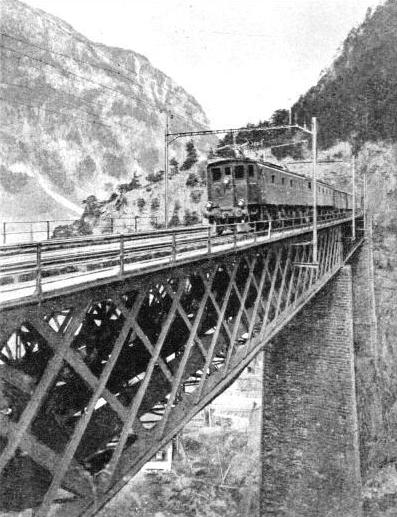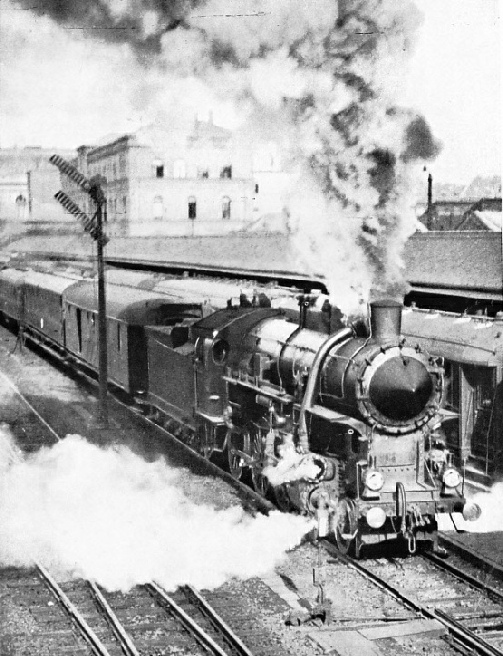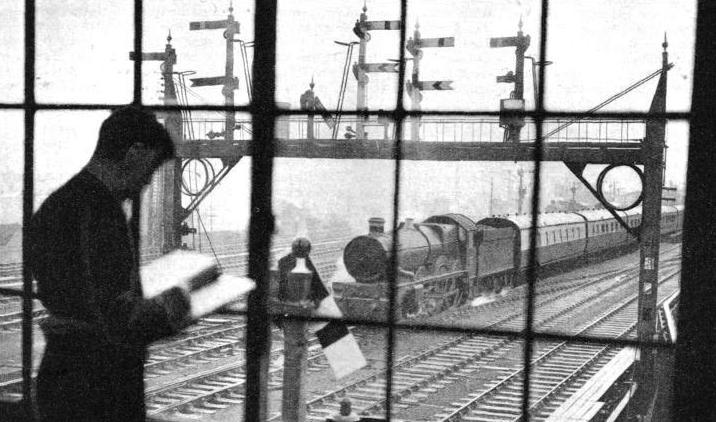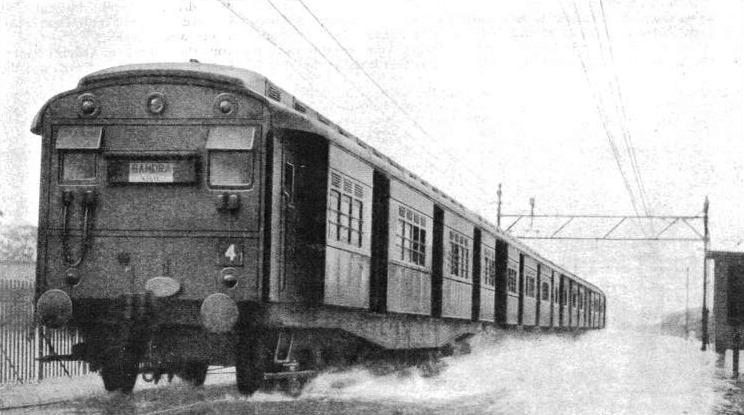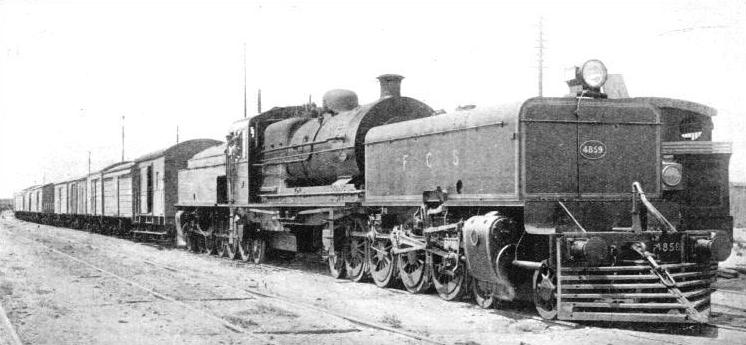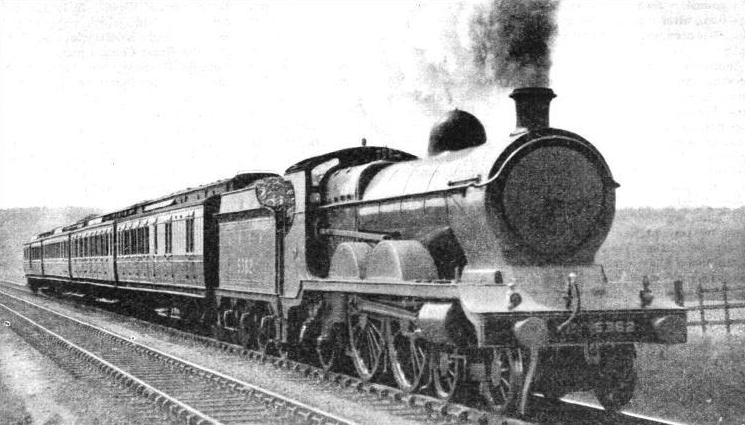
© Railway Wonders of the World 2012-


Part 49


Part 49 of Railway Wonders of the World was published on Friday 3rd January 1936.
This issue contained a black and white art plate showing an express train leaving Budapest. The plate was attached to page 1549, or the fifth page of this number.
The Cover
This week’s cover shows one of the celebrated LMS express engines of the Stanier “5XP” class. The locomotive has three cylinders 17 in by 26 in, driving wheels of 6 ft 9 in, a grate area of 29½ sq ft, a working pressure of 225 lb per sq in, and a tractive effort of 26,620 lb. It weighs with tender 134 tons, and has an an overall length of 64 ft 9 in.
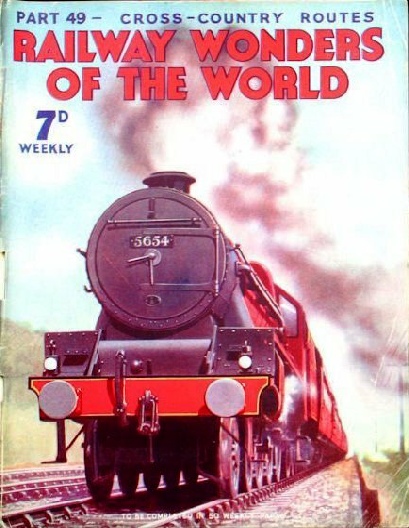
Seen From the Train
Everyone who travels by train has doubtless noticed from the carriage window the signals, mile-posts, and gradient posts, as well as other less familiar track-side signs, but few save the experts can say exactly what they all signify to the railwayman. And it is just these objects - signals, permanent way signs, speed restriction notices, and so forth - that are lucidly explained in a suitably illustrated chapter which has been carefully prepared.
(Pages 1549-1552 )
A Signal Gantry
A SIGNAL GANTRY viewed from a signal-box at Reading on the Great Western Railway, showing home and distant signals. On the right is a home signal with a miniature “calling-on” arm underneath. The man at the window is “checking” trains as they pass and noting the times of their passing the box. The signals are of the “lower quadrant” type.
(Page 1549)
Electrification Overseas
Although steam-hauled trains are still a vital part of a railway, there are few among us who would deny the advantages of electrification where - as in Switzerland - it is both necessary and economically justifiable. The British Empire boasts several extensive electrified areas, such as that in the Union of South Africa described in part 48. This chapter describes the electrified routes of India, Canada, New Zealand, and Australia. In India, where the first electrification scheme was inaugurated in 1925, the Great Indian Peninsular Railway controls 182 route miles of electrified line, including a busy suburban area around Bombay. The Harbour Commissioners of Montreal operate the electrified lines of the port of Montreal on which run some of the world’s most powerful electric freight locomotives. New Zealand has electrified lines through the Empire’s longest tunnel, the Otira Tunnel; while in Australia, the cities of Melbourne and Sydney possess excellent suburban systems.
(Pages 1553-1557 )
An Oxford-York Through Train
MANY IMPORTANT THROUGH TRAINS between the north and south of England run via York, Sheffield, Nottingham, Leicester, Banbury, and Oxford. At Banbury the Great Western takes over the west-bound trains from the Great Central Section of the LNER. Above is an Oxford-York through train at East Leake (Notts). The locomotive is a Great Central “Atlantic” and the coaches are Great Western stock.
(Page 1567)
A Heavy Goods Engine
HEAVY GOODS ENGINE of the “Beyer-Garratt” 4-8-2+2-8-4 articulated type employed on the lines of the Buenos Aires Great Southern Railway. The leading dimensions of this locomotive are: cylinders (four) 17½ in by 26 in, diameter of coupled wheels 4 ft 7½ in, boiler pressure 200 lb per sq in, total heating surface 2,649 sq ft, and total weight in working order 165½ tons.
(Page 1560)
Cross-Country Routes (Part 1)
There is a tendency to overlook the important cross-country trains of Britain when the four big systems come under discussion; routes to and from London are certainly the most talked about, since it is on these that the famous “flyers” work. Nevertheless, the British cross-country lines, such as those from Derby to Bristol, or from Liverpool to Leeds, are of little less importance, and these are described in this chapter. The article concludes in part 50.
(Pages 1566-1572 )
The Kerstelenbach Viaduct
CROSSING KERSTELENBACH VIADUCT, 182 ft above the level of the stream, on the St Gothard route, near Amsteg. This was the first of the Swiss main lines to be electrified, and it is one of the busiest routes in the country. The express here illustrated is climbing the gradient, 18 miles in length, which reaches its summit level at Goschenen, 3,640 ft above sea-level.
(Page 1544)
Leaving Budapest
LEAVING BUDAPEST. An express train departs from the Central Station in the Hungarian capital. About 4,565 of the 5, 350 miles of track open in Hungary are worked by the State. The pioneer line in the country was constructed between 1839 and 1846, and State ownership of the railways dates from 1868. The present-day State system is centred on Budapest and some of the liens have been electrified. The railways possess some 1,940 locomotives, 40,000 freight wagons, 3,460 passenger coaches, 112 rail motor cars, and a number of other vehicles.
(Attached to page 1549)
Over Flooded Lines
OVER FLOODED LINES caused by the heavy rains of the monsoons in Bombay. The city’s heavy suburban traffic is handled by electric trains working on the 1,500 volt DC overhead transmission system. The electrified lines around Bombay are controlled by the Bombay, Baroda and Central India Railway, and by the Great Indian Peninsular Railway.
(Page 1555)
British Enterprise in South America
An account of two big British concerns in South America - the Buenos Aires Great Southern Railway and the Nitrate Railways Company of Chile. The total mileage of the former railway is 5,085, which is the most extensive of the privately owned systems in the Argentine. It links many important ports in the country, including Buenos Aires, the capital. The Nitrate Railways Company connects the nitrate ports of Iquique and Pisagua and has a mileage of over 400. Despite difficulties of operation caused by heavy gradients, the company has conveyed as much as 900,000 tons of nitrate in one year.
(Pages 1558-1565 )
Contents of Part 49
North American Railroads (Part 2)
Power Production in the Alps
Leaving Budapest (art plate)
Seen From the Train
Electrification Overseas
British Enterprise in South America
Cross-Country Routes (Part 1)
The “Daylight Express”
THE “DAYLIGHT EXPRESS”, on the Southern Pacific’s line, is one of the chief trains on that system. It links San Francisco and Los Angeles, a distance of 471 miles by the route taken. This train includes an observation car with a large open-air platform, a lounge car, and a restaurant car. Its coaches are painted pearl-grey.
(Page 1542)
Power Production in the Alps
On a normal summer’s day the Swiss railways consume approximately a million kilowatt-hours of current in operating their electrified routes. This energy is derived from Switzerland’s vast store of “white coal” - water power. Recently, my colleague, Mr Cecil J. Allen, was conducted by the Swiss engineers up a remote mountain gorge of the Rhone to inspect a modern wonder - a colossal barrage designed to hold a great volume of water serving as a constant source of supply for the new power station at Sion. Right in the heart of the Alps there has been constructed an artificial lake, over three miles in length, which feeds a power station ten miles away in the Rhone Valley. Tunnels have been driven through the mountains, and immense steel pipe-lines have been built to bring the water to the turbines. The height from which the water descends through the pipes is 5,740 ft; this easily constitutes a world’s record. This chapter, written by Mr Cecil J. Allen, describes this new Alpine power scheme. It also includes a description of the important Barberine dam and power station, which produces current exclusively for the railways. The Barberine dam, completed in 1925, forms part of one of the biggest power schemes in Europe.
(Pages 1543-1548 )
